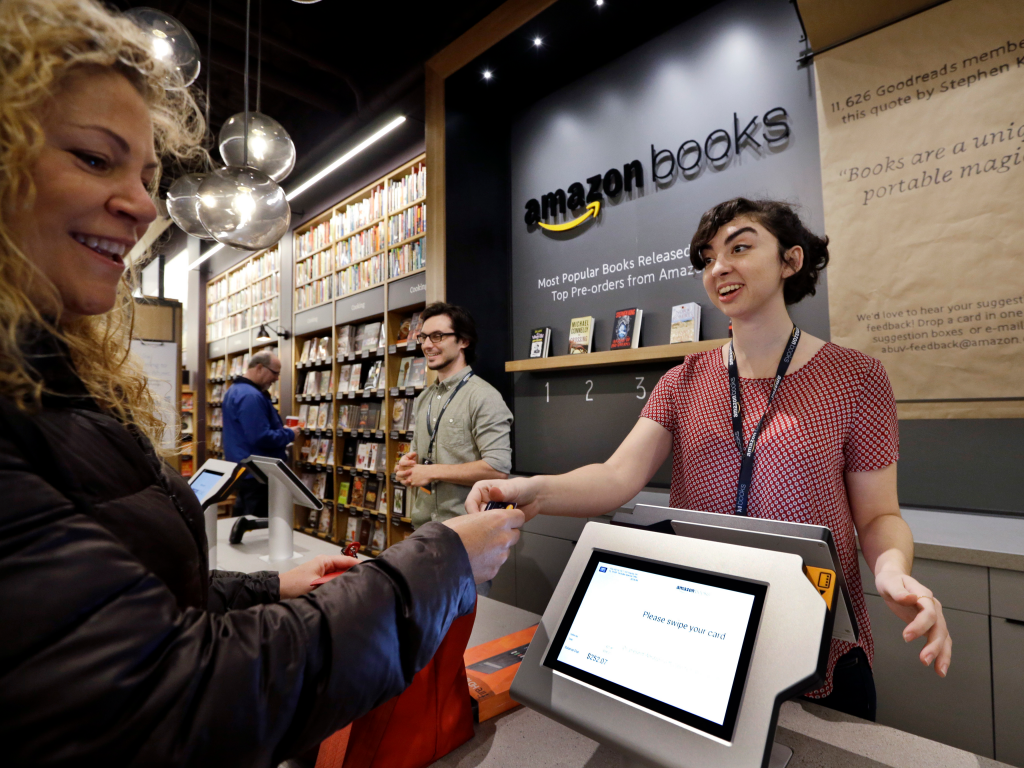- Amazon’s new point-of-sale system can handle online and offline transactions.
- The POS offering links to other Amazon services, including Prime, Flex, and One payment tech.
- Project Santos, an internal Amazon team created to compete with Shopify, is leading the project
Amazon created an internal task force called Project Santos last year to go after Shopify’s core small business merchants.
One of the team’s earliest initiatives is to build a new type of point-of-sale system that can be sold to third-party sellers, Insider has learned.
The new POS system can handle in-store and online transactions, add Amazon check-out options, and provide inventory and business analytics, according to an internal document reviewed by Insider. It can also link to other Amazon services, such as the Prime membership program, the One palm-based indentification technology, and Flex delivery network, the document said.
“This will allow our small business (SMB) customers to unify their online and offline channel management including inventory, offer Amazon One for contactless recognition and payment, and offer a customizable loyalty program that can utilize Prime benefits,” the document said.
Plans for a new POS system gives a glimpse into Amazon's thinking over how to attract more small business sellers to its online marketplace, as a growing number of merchants have been defecting to Shopify and other services lately to sell directly to consumers.
Additionally, it shows how Amazon's physical stores ambition extends beyond just building an array of brick-and-mortar locations. The company also wants to sell software used by merchants in other stores to check-out customers and analyze data - even as Amazon continues to expand its own cashierless technology, rolling it out to two new Whole Foods locations on Wednesday.
If launched, Amazon's new POS system would put the internet giant in direct competition with payment processing companies that offer their own POS solutions, including Square, PayPal, Shopify, and Fiserv's First Data. The global POS software market was worth $9.26 billion in 2020, and is expected to reach $19.56 billion by 2028, according to Grand View Research.
"We believe this offering lets Amazon to do the heavy lifting of order placement and fulfillment at a rate that is more affordable than other competitors, thus allowing SMBs to focus on their product development and growth," the document said.
The project is still in its early stages, and the timeline for launch is unclear. An Amazon spokesperson declined to comment.

'Heavy lifting'
For the new POS system, the Santos team is working in conjunction with the group in charge of the Amazon One palm-scanning payment technology and Amazon's physical stores unit, which is also building out the Amazon Go cashierless stores.
The collaboration is due to the new POS system's need to connect with a variety of other Amazon services. In the internal document, Amazon calls it an "omni-channel POS solution" that includes its own "POS hardware" and integrations with Prime, Amazon One, and Flex delivery programs. It also says other features, like business analytics and customer data, can be managed through a separate "portal for SMBs" being developed by the Santos team.
Sellers will also be able to add to their own websites and stores. There's also the option of allowing customers to pay with their Amazon accounts, the document said. Some features will also enable better "Buy Online Pickup In Store (BOPIS)" services, according to the document.
Amazon already uses another custom-built POS system at its own physical locations, including its bookstores and Fresh grocery stores, according to a person familiar with the matter. Those solutions allow Amazon to offer Prime discounts and additional promotions at check out, among other features.
This existing POS system, however, is not available to external customers, this person said. One reason for keeping it in-house for now is that Amazon's POS system is entirely built in the cloud, making it a less attractive option for stores that may have internet connectivity issues. If a store happens to go offline, Amazon's POS system may not function properly, unlike competing solutions with better contingency plans, this person said. For example, Amazon's backup plan for stores going offline is to offer Prime discounts to all customers, regardless of their membership status, because the current system can't access customer data without an internet connection, this person said.
Amazon launched Project Santos last year as a "defensive" move to Shopify's growing threat as a competitor, Insider and the Wall Street Journal previously reported. There's been a scramble among Amazon executives to respond to Shopify's meteoric rise, prompting even former CEO Jeff Bezos to directly engage in discussions with the Santos team, according to a person familiar with the discussions. The project is led by longtime executive and VP Peter Larsen, who was previously involved in the development of Kindle devices and Amazon's in-house shipping service.
